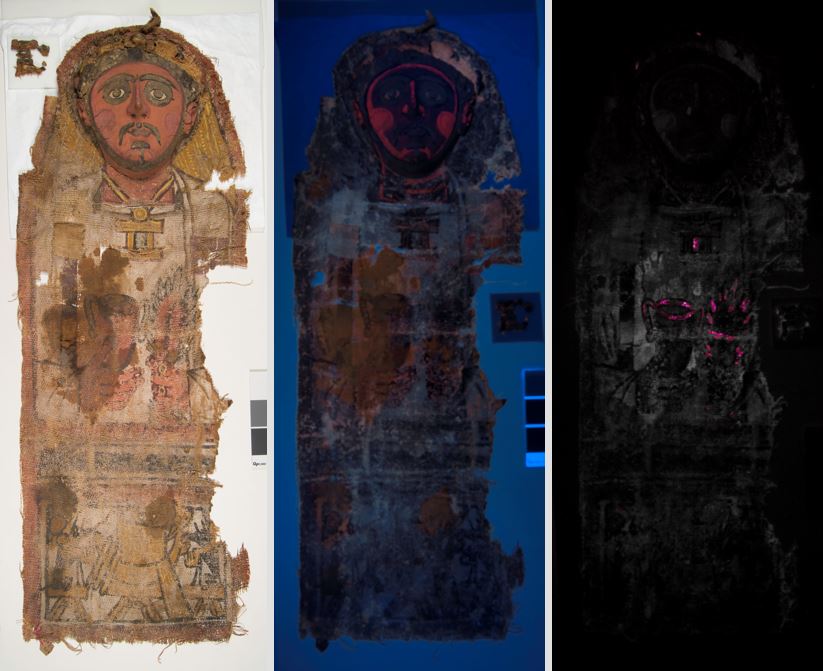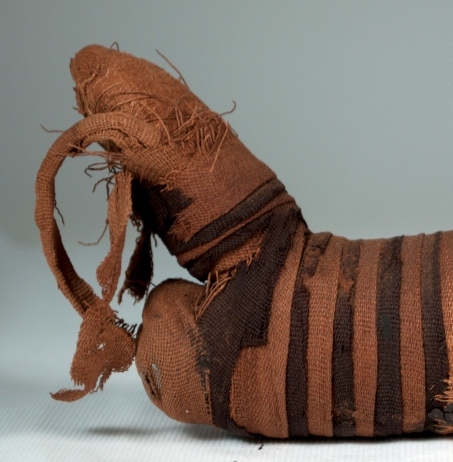Update – this post contains outdated language. We no longer use the term “mummy” and instead use “mummified human individuals” to refer to Ancient Egyptian people whose bodies were preserved for the afterlife. To read more about this decision, follow this link.
After using humidification and four extra hands, the mask is now unfolded! This complete view of the object provides us a wonderful opportunity to look at the materials used in construction and allowed treatment to finally move forward.
Before jumping into treatment, I had the opportunity to perform Multispectral Imaging (MSI) on the mask, allowing us to analyze some of the pigments non-destructively and with great results.
Under ultraviolet illumination, a bright pink fluorescence was visible (middle), indicating the use of a madder lake pigment in the cheeks and to accentuate the face and hands. I also used visible induced IR luminescence to pinpoint the use of Egyptian Blue pigment in the crown, jewelry, and green leaves (right, Egyptian Blue highlighted in pink). This is a material commonly found in Roman period Egyptian artifacts.
In addition to finding out some of the materials used, I also completed full documentation of the object. Although some of the surface is still intact, the paint layer is in poor condition with areas of flaking and powdering. There is also a large loss to the textile along with some smaller tears and holes.
As my first order of business, the paint needed to be stabilized. This paint, like many other Egyptian painted surfaces, is sensitive to water and adhesives can cause staining and darkening. This meant a lot of testing was required to find the perfect adhesive for the job.
Using both testing panels and small, discrete areas of the surface, I tested adhesives until I found funori, a seaweed-based polysaccharide. This material preserved the matte and light tones of both the paint and ground layers.
As treatments usually go, you sometimes get unexpected bumps along the way. As I was consolidating I discovered that the flesh tones in the face and hands were significantly more sensitive to the water-based adhesive. I quickly had to rethink my approach, ultimately using a methyl cellulose in 50:50 ethanol: water for the hands, face, and larger flakes in the yellow framing the face.
Once consolidation was complete, I moved on to the next hurdle: the molded mud plaster mask. A large gap is present between the fragmented mud plaster crown and the textile below. To support the plaster and its mends, I made a removable fill of carved Volara foam and Japanese tissue, all toned with Golden acrylic paints to make the supports more discrete.
Fragmented, actively shifting, and detached mud plaster was mended with a 40% AYAT in acetone applied by brush and syringe. Unstable and weightbearing cracks and gaps were filled with a 25% AYAT in acetone that was bulked with microballoons and toned with dry pigments. Fill material was applied with syringed, shaped with a brush and wooden skewer, and smoothed with a little bit of acetone. A thin toning layer of acrylic paint was applied to fills to make them a warmer tone, but still distinguishable from original material.
And with that, the treatment is complete! The mask is now stable and will be returned to storage safe and sound.
- Amaris Sturm is a second-year graduate student in the Winterthur/ University of Delaware Program in Art Conservation. She recently completed her summer internship in the Penn Museum’s conservation labs.






























